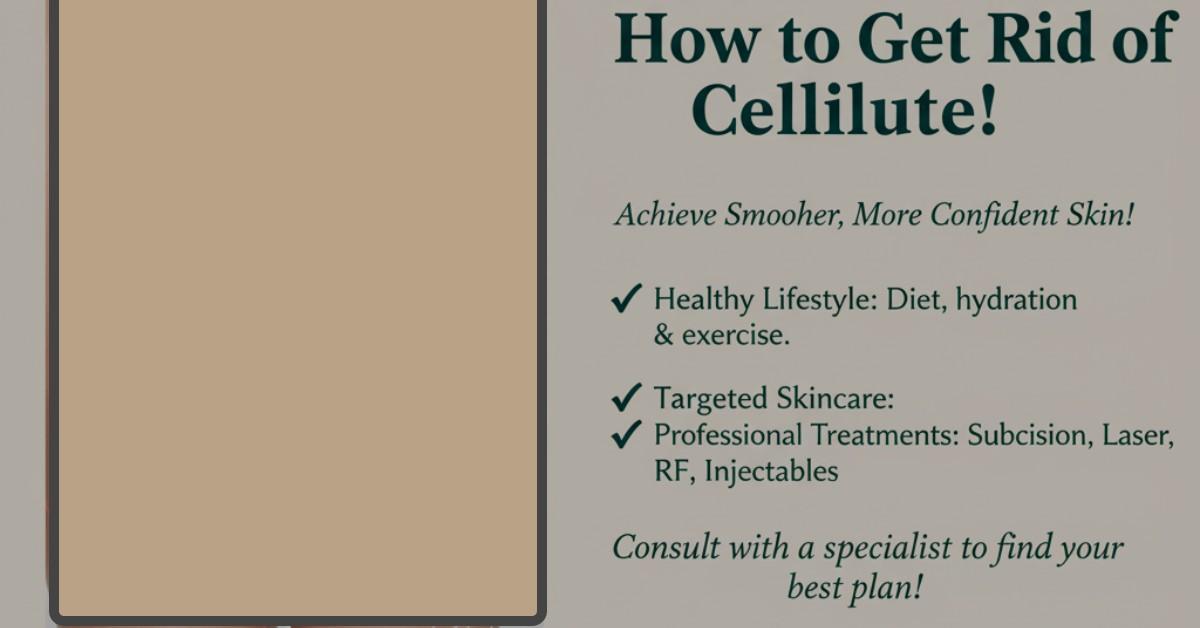Consulting with a qualified aesthetic professional is the best way to determine the most effective treatment plan for your specific needs.
Cellulite is a common, harmless skin condition that causes the skin on the thighs, hips, buttocks, and abdomen to appear dimpled or lumpy, often described as having an "orange peel" texture. While incredibly common—affecting up to 90% of women—it can be a source of frustration. Understanding the underlying causes and exploring a combination of lifestyle changes and professional treatments are the best approaches for learning how to get rid of cellulite or, more realistically, how to significantly reduce its visibility.
The Cause of Cellulite
Cellulite is not simply a fat issue; it’s a structural issue involving the skin and the layer of fat just beneath it.
-
Fibrous Bands: Tough, cord-like bands of connective tissue, called septae, tether the skin to the muscle below.
-
Fat Accumulation: As fat cells accumulate and push upward against the skin, the fixed connective cords pull downward.
-
Dimpling: This push-and-pull interaction creates the uneven surface and dimpling known as cellulite.
Several factors influence this structure and make cellulite more apparent, including hormonal changes (particularly estrogen), genetics, age (as skin loses elasticity), and poor circulation.
At-Home Strategies and Lifestyle Adjustments
A foundational approach to minimizing cellulite starts with maintaining a healthy lifestyle, which improves overall skin health and reduces factors that make the condition more visible.
1. Diet and Hydration
-
Eat a Balanced Diet: A diet high in processed foods, excess carbohydrates, salt, and fat can worsen cellulite by increasing fat storage and fluid retention. Focus on eating foods rich in fiber, lean protein, and antioxidants.
-
Stay Hydrated: Drinking plenty of water is essential. Proper hydration can improve blood circulation and lymphatic drainage, which helps flush excess fluid and may lead to a temporary reduction in dimpling.
-
Bioactive Collagen Peptides: Some studies suggest that taking oral supplements containing specific bioactive collagen peptides may help strengthen the dermal structure over time, thereby improving the appearance of cellulite.
2. Exercise and Toning
Exercise will not eliminate cellulite entirely, but it can dramatically reduce its appearance.
-
Muscle Toning: Building muscle mass under the affected areas helps to tighten the skin and make the dimples less noticeable. Focus on resistance training and targeted exercises like squats, lunges, step-ups, and leg kickbacks.
-
Cardiovascular Activity: Aerobic exercise, such as running, cycling, or swimming, helps to burn body fat. Since excess body fat can make cellulite more visible, fat reduction can contribute to a smoother look.
-
Regularity is Key: Consistent physical activity that combines cardio and strength training is the most effective at-home strategy.
3. Topical and Massage Remedies
-
Retinol Creams: Products containing 0.3% retinol can help by thickening the outer layer of the skin over time, which helps to camouflage the uneven fat layer underneath. Consistent use for at least six months is required to see noticeable effects.
-
Caffeine Creams: Topical creams with caffeine can temporarily dehydrate the fat cells and stimulate blood flow, which may temporarily reduce the visibility of cellulite.
-
Massage and Dry Brushing: Vigorous massage, either manually or using specialized tools like foam rollers, can temporarily improve lymphatic drainage and blood flow, leading to a temporary plumping of the skin that makes cellulite less noticeable.
Professional Medical Treatments
For individuals seeking more significant and longer-lasting results, several medical and minimally invasive procedures are available to address the underlying structural cause of cellulite. These are often the most effective ways to truly tackle the question of how to get rid of cellulite.
-
Subcision (e.g., Cellfina): This minimally invasive procedure involves inserting a tiny needle or blade just under the skin to physically cut and release the tough, fibrous septae that cause the dimpling. This release allows the skin to spring back, smoothing the surface. Results can last for two to three years.
-
Laser Treatment (e.g., Cellulaze): A small laser fiber is inserted under the skin. The laser energy works in three ways: it breaks up the septae, melts some of the fat cells, and stimulates collagen production to thicken the skin. Results can last a year or longer.
-
Injectable Treatments (e.g., Qwo): This involves injecting an enzyme directly into the cellulite dimples. The enzyme works to break down the collagen in the fibrous bands, smoothing the skin.
-
Radiofrequency and Ultrasound Treatments: Non-invasive devices use heat energy (radiofrequency or ultrasound) to target and destroy fat cells, tighten the skin, and stimulate collagen production. Multiple sessions are typically required, with results lasting six months or more.
-
Acoustic Wave Therapy: This non-invasive treatment uses sound waves to break up the fibrous connective tissue and stimulate collagen production, which may reduce the appearance of cellulite over several sessions.
While no single method can guarantee the complete and permanent removal of cellulite, a comprehensive plan that combines targeted lifestyle improvements with advanced, clinically proven treatments can significantly reduce its appearance and help you achieve a smoother skin texture. Consulting with a qualified aesthetic professional is the best way to determine the most effective treatment plan for your specific needs.

